When people mention professional burglar alarm systems, what exactly are they referring to? What characteristics qualify a burglar alarm system as “professional”? What features set them apart from others? How do professional security systems differ from general home security systems that may just be a part of a smart home system?
What is a Professional Burglar Alarm System and Why is it Important?
What exactly is a professional burglar alarm system? The answer becomes clear when we compare it to general, less sophisticated systems.
General burglar alarm systems, often lacking thorough consideration and design, can lead to a host of issues that compromise overall security. These systems are notorious for generating false alarms, which not only cause unnecessary panic but also desensitize users over time, potentially leading to complacency during real emergencies. Furthermore, equipment failures and inadequate signal coverage are common, resulting in insufficient protection for properties. Beyond technical deficiencies, non-professional systems often lack integration with broader security infrastructures. This means that during critical moments, such as break-ins or emergencies, these systems might fail to trigger a coordinated response promptly, putting facilities and individuals at greater risk. Additionally, the absence of professional monitoring places the full burden of responding to potential threats on homeowners or office managers, which can be both stressful and inefficient.
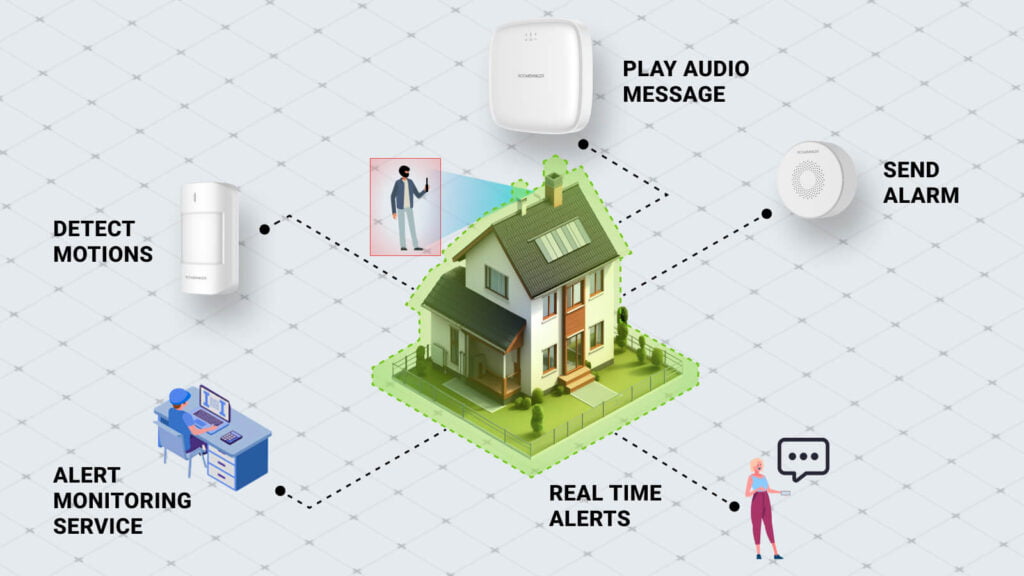
In contrast, professional burglar alarm systems provide robust solutions to these challenges, with extensive consideration given to hardware performance, software reliability, functional logic, and more. These systems typically integrate advanced technologies and reliable monitoring services to ensure prompt responses to any security breaches. In the sections that follow, we’ll explore six must-have features for professional burglar alarm systems.
Also read: DIY vs Professional Home Security Systems
Feature One: A Professional Burglar Alarm System Must Have Multiple Channels to Communicate with the Outside World
A professional burglar alarm system should employ various communication channels, such as GSM, Ethernet, and Wi-Fi, to transmit alarm information to users and security service providers like Central Monitoring Stations (CMS) or Alarm Receiving Centers (ARC).
Relying on a single network connection for a smart home security hub is risky. For example, a power outage could render Wi-Fi unusable, an Ethernet fault might disrupt the connection, or a SIM card could face issues due to insufficient balance or service provider problems. Any of these scenarios could prevent crucial alarm information from being quickly and accurately delivered to users and security companies.
However, if a burglar alarm system is equipped with multiple communication channels (often referred to as redundancy mechanisms), where one serves as the primary channel and the others act as backups, it becomes far more reliable, as the simultaneous failure of multiple channels is less likely. In the event of a channel failure, the system can continue to operate normally via a backup channel. The more communication channels a system has, the higher the chances of promptly informing the user and security organization of a threat.
Additionally, it is essential for these channels to be of different types. For instance, if only multiple GSM modules are installed in the control panel without other communication channels, the system effectively has only one channel. If GSM frequencies are jammed, the system could be cut off from the outside world.
Also read: alarm system with cellular backup
What Communication Channels Does Roombanker Use?
The Roombanker home security hub supports three parallel network connection methods: Wi-Fi, Ethernet, and cellular networks. Should one communication line fail, the system immediately switches to another and sends fault information to the user and connected ARC or CMS, ensuring the stability of the system’s operation and instant emergency support.
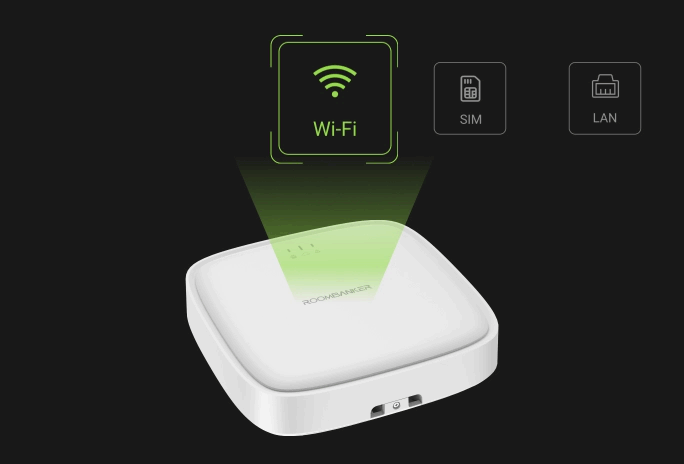
Feature Two: A Professional Intrusion Alarm System Must Use a Cloud Service for Remote Access and Security Monitoring
Modern IoT-enabled burglar alarm systems leverage cloud servers as the central data hub of the entire security framework. The cloud server acts as an intermediary between the alarm control panel and the alarm system application, allowing users and security service providers to access the home security system from anywhere, at any time. It sends informative push notifications regarding system events and alarms, making the security and stability of cloud services crucial in this process.
Additionally, in a professional burglar alarm system, cloud servers monitor the connection with security equipment and its functionality by polling the control panel. The higher the polling frequency, the faster the server can detect issues and alert users and the security company about the situation.
How Does the Roombanker Alarm System Utilize Cloud Services?
Roombanker has deployed cloud services across Europe, the Americas, and Asia, ensuring that users worldwide can efficiently, conveniently, and reliably operate their smart security systems.
Beyond enabling control of hubs through applications and sending push notifications, the Roombanker Cloud service is responsible for displaying current security system data. The service regularly communicates with the hub, updating device statuses in the Roombanker applications (RB-Link). If the hub disconnects, the Roombanker Cloud service immediately sends an alarm to users and the security companies.
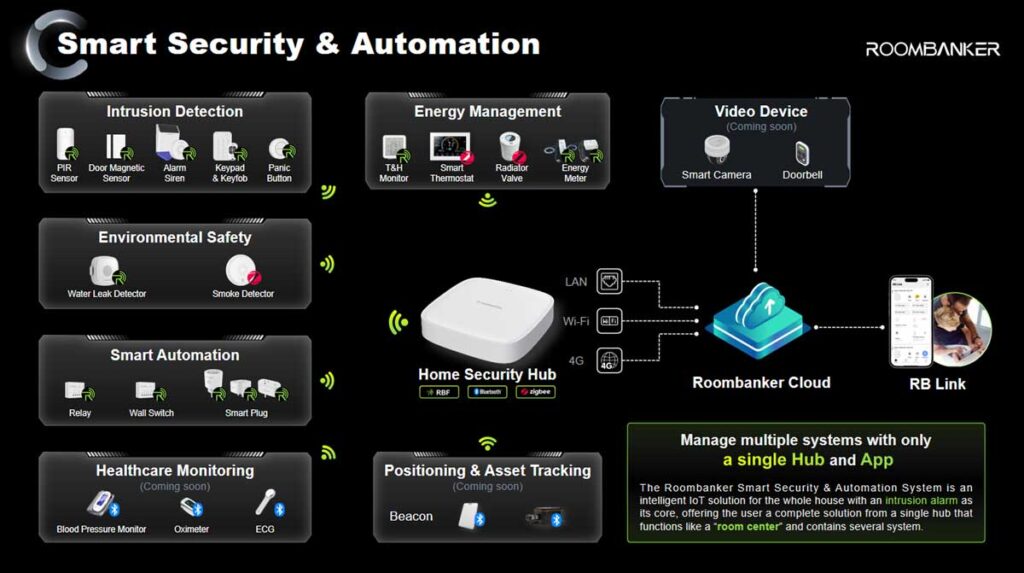
Feature Three: Detectors and Peripherals of a Professional Burglar Alarm System Must Use Reliable Technology to Communicate with the Control Panel
In wireless burglar alarm systems, detectors, sensors, and control devices rely on radio technology to transmit data to the central home security hub. To ensure maximum security, communication must be exceptionally stable, with even brief interruptions being unacceptable. Such disruptions can delay the transmission of an alarm or, worse, prevent users and the security company from being alerted to the alarm at all.
Professional burglar alarm systems typically operate at frequencies of 433 MHz or 868 MHz and use a frequency band rather than a single fixed frequency for communication between the control panel and the detectors. This allows the system to automatically change the operating frequency in the event of accidental or intentional interference—a technology known as frequency hopping.
Also read: 868 MHz alarm system
What Radio Technology Does Roombanker Use?
Roombanker’s RBF communication technology provides a stable connection between the home security hub and various devices. It supports dual frequency bands of 868 MHz and 915 MHz, with a maximum communication distance of up to 3500 meters in open, interference-free areas, effectively covering even larger homes. Additionally, it utilizes multi-frequency FHSS (Frequency Hopping Spread Spectrum) technology, supporting up to 50 frequency bands for hopping. This allows the system to quickly switch to other bands in case of interference, avoiding congestion and ensuring reliable communication.
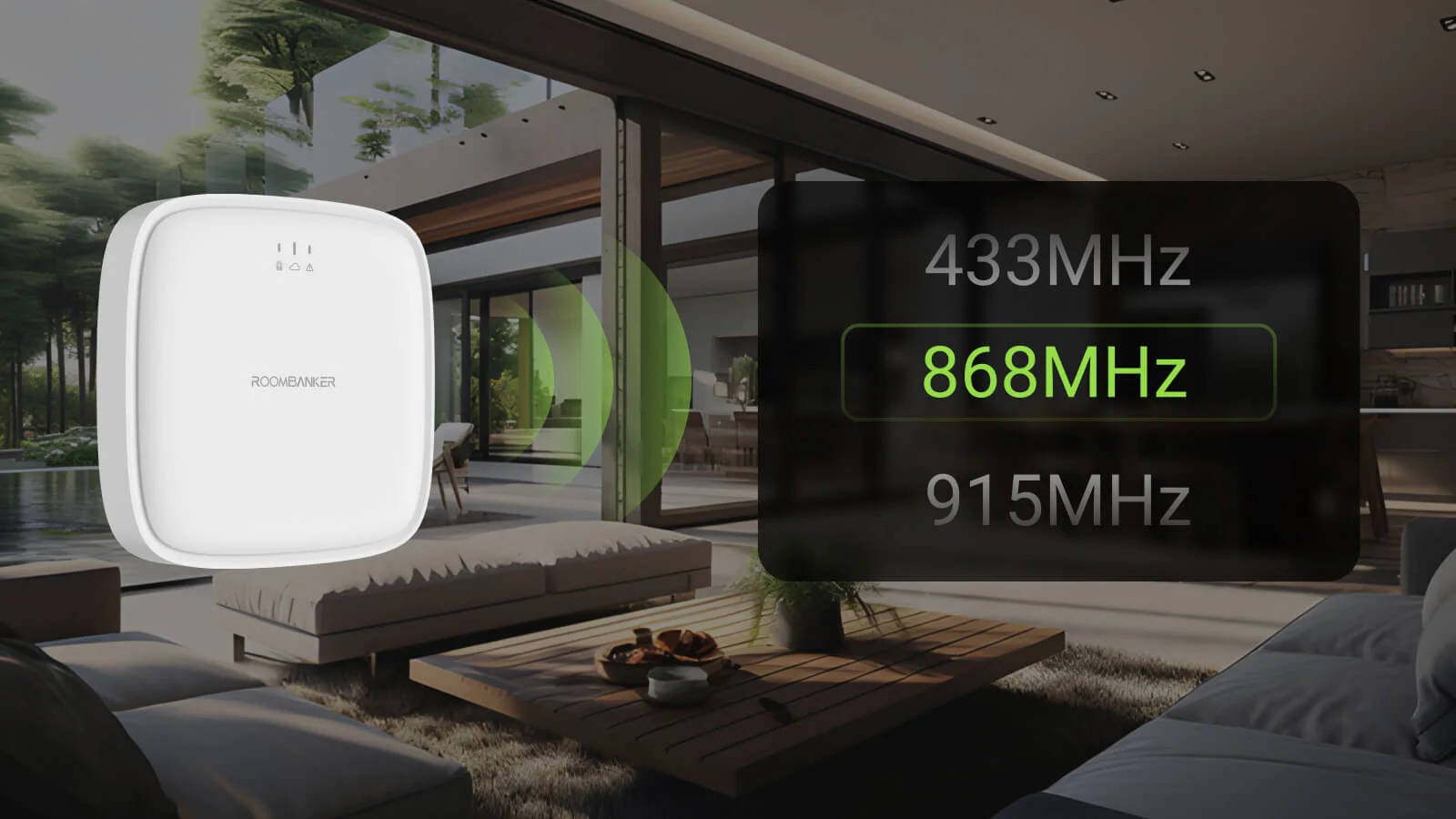
Feature Four: Communication Between Devices in a Professional Burglar Alarm System Must Be Bi-directional
In professional burglar alarm systems, communication between devices can be either one-way or two-way. In one-way communication, detectors only transmit alarms and system events to the home security hub without receiving feedback. This means that if communication is interrupted due to device failure or external disruption, the home security hub remains unaware, leaving users and security companies uninformed of potential security vulnerabilities.
In systems featuring bi-directional communication, the control panel and detectors exchange information continuously. When a detector triggers an alarm, it continues to send the signal until the control panel confirms receipt. This eliminates the risk of data loss during brief connection interruptions. Additionally, the control panel can modify device settings and poll the devices to check their connection and status, resulting in a system that is significantly more reliable.
How Does Roombanker Alarm System Utilize Bi-Directional Communication?
Roombanker’s RBF communication technology enables two-way communication between the home security hub and various peripheral devices, greatly enhancing the system’s control capability and stability. In this bi-directional system, information is continuously exchanged between the security hub and detectors. When a detector issues an alarm, it continues sending the information until the security hub acknowledges receipt, ensuring no data loss during brief connection interruptions. The home security hub can proactively change device settings and poll the devices to check their connection status and operational conditions, making the system significantly more reliable than one-way communication.
Specifically, devices send status reports (or heartbeat data) to the home security hub at regular intervals. The home security hub responds to detectors to confirm receipt of the reports and updates the device status in the user app. If a device fails to respond during this process, the home security hub determines that the device may be offline and promptly notifies the user and security company.
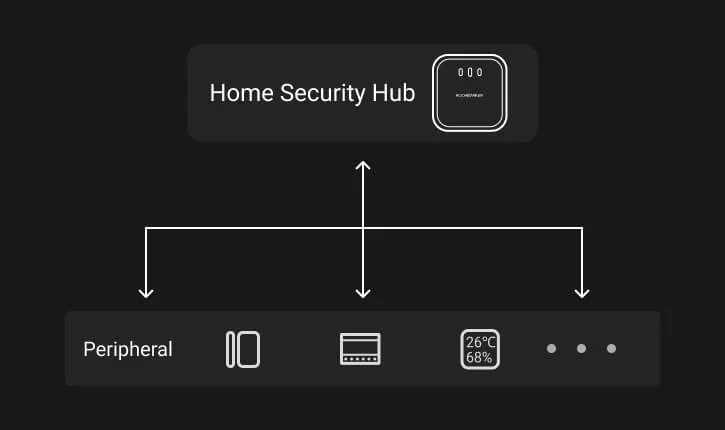
Feature Five: A Professional Burglar Alarm System Must Encrypt Data and Be Protected from Fraud
In a professional burglar alarm system, ensuring that data transmission between detectors and the home security hub is encrypted and safeguarded against fraud is paramount. This critical security feature prevents devices from being tampered with by attackers and, in the worst-case scenario, protects against the misuse of remote-control devices, thereby preventing criminals from gaining full control of the security system.
The most secure systems encrypt their radio signals with a complex algorithm. The more sophisticated the encryption, the harder it is for hackers to breach the system and gain administrative access. For instance, cracking a 128-bit AES encryption could take hundreds of years, whereas an alarm system with outdated or primitive encryption can be compromised with a code grabber in just minutes.
How Is Roombanker Protected from Fraud?
Roombanker sets a high standard in this area by utilizing the AES-128 encryption algorithm to ensure the stability and reliability of data transmission. Furthermore, for communication between the hub and the Alarm Receiving Center (ARC), Roombanker offers three encryption options: AES-128, AES-192, and AES-256. This range of choices not only elevates the overall protection level of the system but also ensures the highest level of security for each piece of information during transmission.
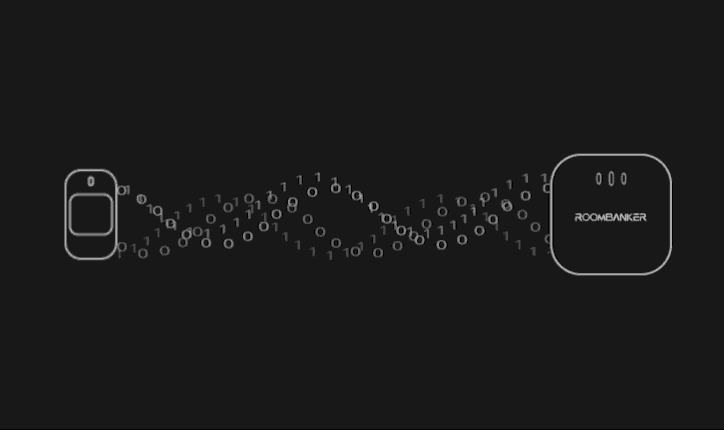
Feature Six: A Professional Burglar Alarm System Must Connect to a Security Company’s Monitoring Center
While a burglar alarm can identify threats quickly, it is not sufficient on detection alone—you need to respond appropriately. Upon receiving an alert from the alarm system, a user can contact the police directly. However, dealing with criminals independently is not advisable. It’s far more rational to entrust the response to professionals by connecting your security system to a security company’s monitoring station.
The ARC/CMS (Alarm Receiving Center/Central Monitoring Station) is responsible for 24/7 real-time monitoring of all connected security system devices. It processes alarm signals from frontend devices such as cameras, PIR motion sensors, and alarm sirens. When an alarm signal is received, ARC operators immediately verify the alarm to confirm its authenticity, effectively preventing false alarms. Once an event is confirmed, the ARC promptly notifies relevant emergency services, such as police, fire departments, or security personnel, ensuring a timely response.
How to Connect Roombanker to an ARC or Monitoring Station?
Roombanker’s home security hub is compatible with both SIA and CID protocols, ensuring stable integration and performance across different security standards. Roombanker offers three flexible integration modes to meet various security needs:
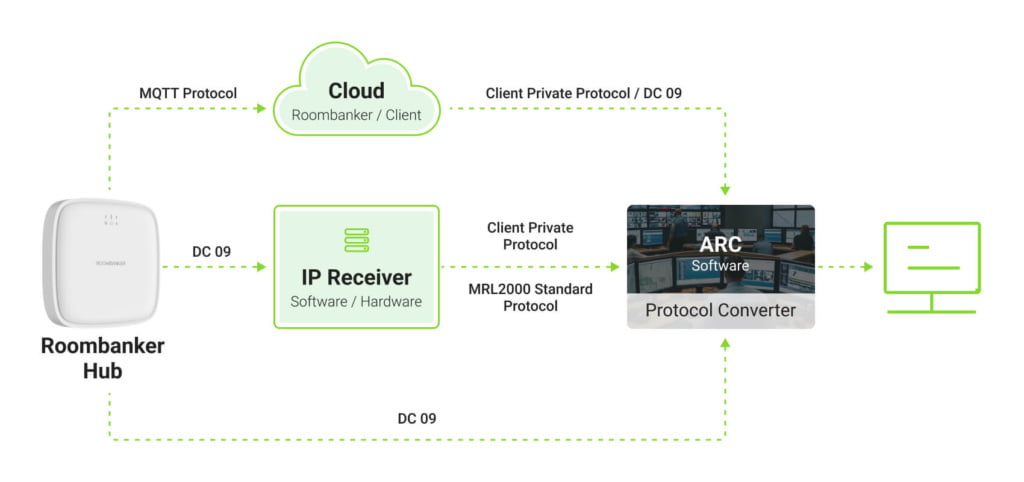
Cloud-Based Transmission: The home security hub sends data in MQTT format to the cloud server, which then converts this information into the ARC’s proprietary DC 09 protocol before forwarding it to the ARC platform.
Direct Transmission to IP Receiver and Protocol Conversion: The smart hub sends data directly in the DC 09 format to an IP receiver. This IP receiver acts as an intermediary, converting the data into either the ARC’s specific protocol or the MRL2000 standard protocol, which is then sent to the ARC platform for action.
Direct Protocol Conversion: The home security hub sends data in the DC 09 format directly to the ARC’s protocol converter. The protocol converter translates the protocol and directly sends the information to the ARC platform. This dedicated device translates the data into the ARC’s internal language for immediate monitoring.
Final Words
Investing in a professional burglar alarm system is essential for ensuring the security and safety of both residential and commercial properties. With advanced features, these intrusion alarm systems provide complete protection against potential threats. As our world becomes increasingly interconnected and complex, having a sophisticated security infrastructure not only offers peace of mind but also ensures a rapid and effective response to any security breach.
Roombanker Wireless Security Alarm System combines ease of use with professional-grade features, offering effortless DIY installation and set up while integrating professional-grade features, including advanced detectors, a dedicated security hub, and supporting integration with Alarm Receiving Centres, etc, making it the go-to choice for a reliable wireless security alarm system, supporting intrusion alarm, fire & water leak alarm, panic alarm, etc., serving an array of small business and residential properties.
As we continue to innovate and enhance our offerings, we are looking to expand our global reach by partnering with dedicated alarm system distributors. If you are interested in being part of a successful story and bringing top-tier security solutions to your market, we invite you to join us as a distributor. Together, we can make a significant impact in safeguarding homes and businesses worldwide. Contact us today to explore this exciting opportunity and become a key player in the security industry.
